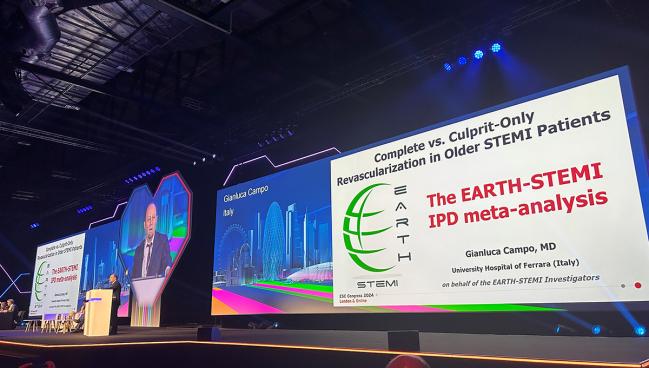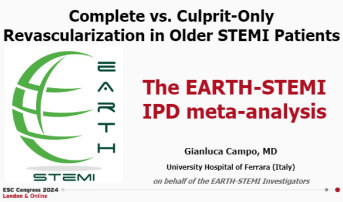Complete Revascularization Better for Older STEMI Patients: Meta-analysis
An early CV benefit was apparent, although there’s still some question about the longer-term impact versus culprit-only PCI.

LONDON, England—Patients ages 75 and older with STEMI and multivessel coronary disease appear to fare better if they undergo complete revascularization rather than culprit-only PCI, the EARTH-STEMI meta-analysis suggests.
More comprehensive revascularization was associated with a significantly lower rate of death, MI, or ischemia-driven revascularization—at least through 4 years of follow-up—and a lower risk of CV death or MI compared with opening the culprit artery alone during primary PCI, Gianluca Campo, MD (Azienda Ospedaliero Universitaria di Ferrara, Cona, Italy), reported here at the European Society of Cardiology (ESC) Congress 2024. There were no differences in various safety outcomes.
The findings, published simultaneously online in Circulation, confirm and expand upon those of prior trials that have evaluated the impact of complete revascularization, like COMPLETE and FIRE, he said.
“Complete revasc should be considered a reliable strategy to reduce ischemic endpoints in the first 3 [or] 4 years following [an] acute event in older patients with ST-segment elevation MI and multivessel disease,” Campo said at a press conference, adding that additional data are needed on the longer-term effects, particularly regarding overall mortality.
Commenting for TCTMD, ESC spokesperson Erik Rafflenbeul, MD (Schön Klinik Hamburg Eilbek, Germany), noted that the number of older patients who are being treated with PCI is increasing as the population ages.
“This is why it's important to look at complete revascularization” in this group, who are often treated more hesitantly, Rafflenbeul said. “I think it's important to emphasize that it's safe, that it's feasible.”
EARTH-STEMI
Prior trials have shown that complete revascularization improves outcomes in patients with STEMI, and FIRE affirmed those benefits in patients 75 and older. But the issue was not settled since COMPLETE had a small proportion of elderly patients and FIRE enrolled a mix of STEMI and NSTEMI patients and reported results out to only 1 year. In addition, the FULL REVASC trial released earlier this year raised questions about the long-term benefit of complete revascularization.
To explore this issue further, Campo and his colleagues performed a meta-analysis of individual patient data from seven trials—COMPLETE, FIRE, FULL REVASC, DANAMI3-PRIMULTI, Compare-Acute, CvLPRIT, and a trial of 100 diabetic patients. Of all participants in those trials, 19% were 75 or older. The meta-analysis included 1,733 patients from that age group (median age 79; 34% women) who were randomized to complete or culprit-only revascularization.
Follow-up varied widely across trials, ranging from a median of 6 months in the 100-patient trial to 6 years in CvLPRIT. Overall, the median follow-up was 2.5 years.
The rate of the primary composite endpoint of death, MI, or ischemia-driven revascularization was 20.8% following complete revascularization and 25.2% following culprit-only PCI. The difference between groups remained significant up to 4 years (adjusted HR 0.78; 95% CI 0.63-0.96), but not throughout the entire follow-up (adjusted HR 0.83; 95% CI 0.69-1.01). It’s important to note, Campo said, that a limited number of patients (20%) were followed for longer than 4 years.
Considering the longest follow-up, a key secondary endpoint of CV death or MI favored complete revascularization (11.5% vs 15.1%; adjusted HR 0.76; 95% CI 0.58-0.99). There was a significant advantage for ischemia-driven revascularization also (4.9% vs 9.1%; HR 0.52; 95% CI 0.34-0.85).
Overall death was similar in the complete and culprit-only groups (14.7% vs 14.6%; HR 1.03; 95% CI 0.80-1.32), with a nonsignificantly lower rate of CV death following complete revascularization (6.8% vs 8.7%; HR 0.79; 95% CI 0.56-1.02) accompanied by a nonsignificantly higher rate of noncardiovascular death (7.8% vs 5.9%; HR 1.40; 95% CI 0.97-2.02).
Rates of safety events—including stroke, acute kidney injury, stent thrombosis, and major bleeding—were not significantly different between groups.
Complete Revascularization ‘Should Be the Goal’
Starting her discussion of the EARTH-STEMI results after Campo’s presentation, Renate Schnabel, MD (Universitätsklinikum Hamburg-Eppendorf, Germany), noted that current guidelines recommend complete revascularization either during the index PCI or within 45 days in stable STEMI patients, guidance that hinges on prior research indicating a reduction in CV death or MI—but not overall mortality—with the approach.
She added, however, that there was a limited number of elderly patients included in those trials.
The EARTH-STEMI meta-analysis shows that among this older group—albeit still with a relatively small number of patients—outcomes are better with complete versus culprit-only revascularization, similar to what was shown in FIRE, Schnabel said.
But she highlighted several issues to consider when interpreting the results, including the lack of a reduction in overall mortality, which might be important for an individual who may have many years of life left. Moreover, she said, only 15% of patients in the meta-analysis were 85 or older; women were underrepresented overall, with an imbalance between the two groups; most patients were stable; physiology-guided PCI was used in only 57% of patients; and there was a lack of information on frailty, quality of life, and physical impairment.
But despite these limitations, the meta-analysis was well performed and helps fill an evidence gap, Schnabel indicated.
“Complete revascularization in largely stable older STEMI patients should be the goal,” she said. “There were no safety concerns. And [the] evidence may now support future guidelines and, of course, physician-patient communication and shared decision-making.”
During a panel discussion, Schnabel also highlighted the need to consider different endpoints focused on quality of life and physical impairment when designing trials, with input from patients.
Todd Neale is the Associate News Editor for TCTMD and a Senior Medical Journalist. He got his start in journalism at …
Read Full BioSources
Campo G, Böhm F, Engstrøm T, et al. Complete vs. culprit-only revascularization in older patients with ST-segment elevation myocardial infarction: an individual patient meta-analysis. Circulation. 2024;Epub ahead of print.
Disclosures
- Campo reports research contracts from Sahajanand Medical Technologies, Siemens, GE Healthcare, Eukon, and Insight Lifetech (for the FIRE trial).






Comments